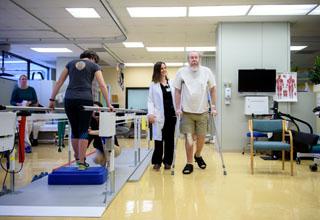What Older Adults Should Do After a Broken Bone
Learn how to manage osteoporosis and how to reduce your risk of a secondary fracture.

If you’re an older adult and you’ve fractured a bone in recent years, you’re not alone. Up to 25 percent of men and 50 percent of women 50 and older will experience a fracture in their lifetime.
Despite these noteworthy statistics, it’s not uncommon for people to relegate bone health to the bottom of age-related wellness concerns. Older adults are likely to focus on what they can do to prevent conditions like cancer, Alzheimer’s disease, or heart disease, believing those represent the greatest risks to quality of life and longevity with age. While aiming to prevent those conditions is a good idea, don’t overlook the importance of bone health!
Broken bones are a leading cause of hospitalizations among women aged 55 years or older, ahead of heart attacks, stroke, and breast cancer. Fractures significantly impact quality of life, causing pain, restricting mobility, and leaving many patients feeling depressed. On top of that, the effects can be long-lasting, resulting in increased use of health care services, a greater likelihood of hospitalization and skilled nursing care, and increased mortality risk for up to 10 years post-fracture.
Understanding why bones fracture
So, what causes all of these broken bones in older people? All too often, the assumption is that a break from a fall or accident is due merely to the blunt force of the impact rather than underlying bone weakness. As the director of the Musculoskeletal Research Center and a senior scientist at the Hinda and Arthur Marcus Institute for Aging Research, I would like to dispel this myth.
Most fractures in older people are due to a combination of a fall and weak bones. A broken bone in an older person who has fallen from a standing height, such as tripping on the sidewalk or slipping on a wet floor at home, is more often than not related to osteoporosis, yet the condition remains underdiagnosed. In fact, once a person has fractured a hip, they have osteoporosis.
Osteoporosis is a skeletal disorder characterized by compromised bone strength. It predisposes those who have it to break bones during falls or even when lifting a heavy object while bending over.
But it’s important to note that osteoporosis is not inevitable with age, and there are steps you can take to protect your bones throughout life. That’s why it’s important to discuss bone health with your doctor, even if you’ve never broken a bone.
Understanding the risk for secondary fracture
Unfortunately, once you’ve suffered a fracture, the risk of another broken bone is substantially increased. A review of Medicare data showed that patients who experienced a first fracture of the hip or spine had a 20-25% chance of a subsequent fracture just within the first year. That is why treatment of osteoporosis following a fracture is so important.
Some doctors have said that we might be able to improve the treatment of patients with fractures by changing the word “fracture” to a “bone attack,” similar to the diagnosis “heart attack.” People having a heart attack always get treatment to prevent another heart attack, but patients with broken bones rarely get treated to prevent another broken bone.
But all is not lost. It just means your routine health care should include osteoporosis management. Learning what you can do to reduce further bone deterioration, improve bone strength, and treat conditions that could lead to serious further injury with medications is key.
As a geriatrician, I treat many patients with osteoporosis, and my research at the Marcus Institute focuses on musculoskeletal conditions. Here are current recommendations from experts in bone and mineral research for the care of older adults who have experienced bone fractures.
Talk to your primary care physician
Involving your primary care physician following a fracture is critical. Lack of communication with patients’ regular health care providers has consistently been identified as one of the key barriers to providing appropriate management for secondary fracture prevention. If your usual health care providers are not aware of your fracture and diagnosis of osteoporosis, they can’t take steps to provide the long-term care required by this chronic condition.
It's also important to find out if certain conditions, such as diseases or medications that can cause bones to weaken, could be contributing to your osteoporosis. Your PCP may refer you to specialists to help understand the full range of conditions that might be causing your osteoporosis, including diabetes, kidney or liver disease, and autoimmune disorders.
Get a bone density test
If a bone density test is not already part of your yearly wellness checkup, it should be if you’ve broken a bone. A bone density scan, also known as a DXA scan, is a type of low-dose x-ray test that measures the density of minerals in your bones. The measurement helps show the strength and thickness of your bones. This test is important to determine how advanced the osteoporosis is and to inform appropriate clinical treatment.
Pharmacological therapies
Since experiencing a broken bone puts you at high risk for another broken bone within the first year, prescription medications should be universally recommended to manage osteoporosis. Pharmacological therapy for osteoporosis reduces the risk of fracture in older patients who have already experienced a hip or vertebral fracture.
It’s important that you understand the risk of a second fracture if you opt out of pharmacological treatment. Make sure you talk to your doctor about the benefits and risks of medication in your case.
Non-Pharmacological treatments
Nutrition
Getting adequate calcium in your diet is important. Ideally, more of the daily calcium requirement should be consumed in foods, including dairy products, as opposed to supplements. A variety of leafy green vegetables such as turnips, mustard, and collard greens and fish such as salmon and anchovies can add a substantial amount of calcium to the diet.
Vitamin D intake is also extremely important. Vitamin D is essential for the absorption of calcium from the gastrointestinal tract. It is synthesized in the skin upon exposure to direct sunlight or ingested in foods such as egg yolks, fish, liver, or supplements. As with calcium, sunlight and diet are the best sources for vitamin D intake. However, Vitamin D supplementation should be advised for patients unable to have sun exposure without sunscreen use and is especially important for older individuals who live in northern latitudes or who are housebound.
Patients rightly have questions about the danger of sun exposure and how to use sunscreen while still getting adequate vitamin D. Sunscreen blocks the body’s ability to manufacture vitamin D from ultraviolet B rays. For example, sunscreen with an SPF of 8 blocks 87.5% of UVB rays from the sun, and an SPF of 30 blocks about 97% of UVB rays. Clothing also blocks UVB rays.
However, keep in mind that only about 10 minutes of sun exposure or less daily is needed to provide vitamin D synthesis, and patients should be cautioned not to abandon sunscreen due to the obvious negative effects.
Lifestyle choices
Eliminate smoking and excessive alcohol consumption. Smoking weakens your bones in several ways, and cigarette smoking is linked with an increased risk of mortality in hip patients who have experienced a hip fracture. Heavy alcohol usage can decrease the strength of your bones.
Exercise and balance training
A preventive exercise strategy should be recommended to people with osteoporosis. Exercise has a number of benefits including:
- Decreased risk of falling
- Improved bone mass and strength
- Enhanced muscle strength
- Improved balance
- better posture
- Increased flexibility of soft tissues
- Improved cardiovascular fitness
- Improved depression
Your PCP may refer you to physical and/or occupational therapists or a physiatrist for evaluation and interventions to improve impairments in mobility, gait, and balance.
Watch a video to learn three chair-based bodyweight exercises you can do at home.
Take precautions in the environment to prevent falls
As the saying goes, an ounce of prevention is worth a pound of cure. I mentioned earlier that falls are the leading cause of fractures in older people, so it stands to reason that fall prevention is important in preventing both initial and secondary fractures. Your PCP should evaluate your risk of falling regularly.
Here are some common-sense steps you can take to prevent a fall in your home.
- Keep rooms and floors free of clutter.
- Keep floor surfaces clean but not slippery.
- Place skid-proof backing on carpets and scatter rugs.
- Keep rooms well-lit.
- Use a rubber mat in the shower/tub.
- Use handrails on stairs, in bathroom.
- Keep a flashlight at bedside.
- Use a portable phone and keep phone and electrical wires out of walkways.
- Wear supportive, low-heeled shoes.
- Do not walk in socks or floppy slippers.
- Keep a week’s supply of prescription medications on hand.
- Arrange for daily contact with a family member or neighbor.
- Contract with a monitoring company for 24-hour response time in an emergency.
Read more about how to prevent falls.
Preventing a secondary fracture is possible
I hope by now you can see how important it is to take aggressive steps to address bone health and prevent secondary fractures. By understanding your risk and working with your primary health care team, you can avoid subsequent fractures if you’ve broken a bone.
Hebrew SeniorLife can also support your wellness goals. We provide outpatient bone density testing at Hebrew Rehabilitation Center in Boston on our DXA machine. If you need to work on regaining strength or improving balance, particularly after a fracture, come to us for outpatient physical and occupational therapies focused on the needs of older adults, with locations in Boston and Dedham.
We also offer an affordable, supervised senior fitness program in Boston. Unlike a large gym, our Get Up & Go program provides fitness plans personalized for your strengths and areas of opportunity and experienced exercise professionals to help you along your journey.
Researchers at the Marcus Institute are currently recruiting participants for the Study to Attenuate Resorption of Skeleton, or STARS, clinical food trial, to evaluate whether a combination of probiotics and prebiotics can help manage bone health over 18 months in 220 women aged 60 and older. The research team will also explore how diet, inflammation, and the gut microbiome contribute to age-related bone loss. If you’re interested in participating in the study, call STARS project director Evelyn O’Neill at 617-971-5800 or contact us online.
Join Our Community: Subscribe to the Hebrew SeniorLife blog for weekly insights on healthy aging and senior living.
Blog Topics
Learn More
Outpatient Rehabilitative Therapies
At Hebrew Rehabilitation Center in Boston and Dedham, MA, we offer adult physical therapy, occupational therapy, and speech therapy using state-of-the-art mobility and treatment equipment.

Senior Fitness
Our exercise physiologists specialize in fitness for older adults and will develop a personalized exercise program for you.




